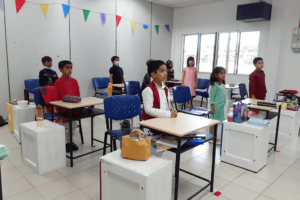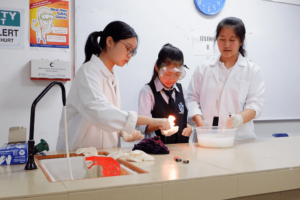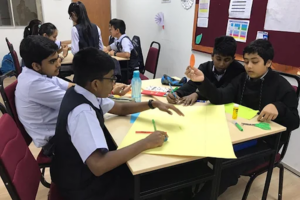
Navigating Education in Malaysia: A Smooth Transition from Preschool to Primary School in Malaysia
Table of Contents When 6-year old Aidan stepped into his primary school classroom for the first time, he confidently greeted his new teacher with
Maintaining our health is vital. Eating right and exercising can help us keep ourselves healthy. Meanwhile, regular physical activity has many health benefits. These advantages include reducing the risk of obesity and depression.
It also improves social outcomes like happiness and trust. Plus, it supports cognitive functions. As a result, it enhances academic performance. Several countries follow WHO guidelines on physical activity.
However, some nations have reduced school physical activity time to focus more on academics. This is done to improve performance at the early years foundation stage. This change may lead to poorer academic results. The activities freshen the mind and help focus. So, they are crucial during the academic journey.
Additionally, increased screen time due to the digital age has worsened mental and physical health among children. This shift to a sedentary lifestyle challenges overall health. Governments and schools should prioritize initiatives promoting physical activity for better health. Further, in this blog, you will uncover more about the impact of physical activities.
Research has discovered that physical activity can improve aspects of executive function. These aspects may be like working memory and quick reasoning to solve problems. The executive function enables us to adjust our behaviour. This will help us achieve goals by coordinating our thoughts and actions. These activities involve skills such as regulating emotions and behaviour to complete tasks.
Strong executive function skills correlate with positive behaviour. It will also lead to healthy choices. Plus, it also helps achieve greater success in school and the job market. Ultimately, these activities have a significant impact on students’ academic lives.

Teachers can strategically use physical activity to enhance positive classroom behaviour. Firstly, they can focus on the duration and intensity of physical activity. A single session of aerobic activity can increase adrenaline and dopamine levels.
As a result, the Cambridge early years curriculum instantly improves attention. Continual aerobic exercise over weeks fosters the growth of neurons in the brain and new blood vessels. It leads to enhanced memory and learning abilities. Different types of physical activities can be applied based on children’s developmental stages. Certain activities are beneficial for promoting self-regulation skills in younger students.
Games like musical chairs require behavioural and emotional regulation. It aids in skill development. Cooperative games, where children work together towards common goals, also improve emotional regulation. For instance, one child leads another with covered eyes. It fosters teamwork and emotional control.
As children transition into adolescence, participating in organized sports demanding behavioural control is crucial. Additionally, holistic practices like yoga have been found to enhance self-regulation during the early years foundation stage. These targeted physical activities help children and adolescents improve emotional regulation skills. This reduces the influence of emotions in the classroom and enhances focus on tasks.
Teachers can create a conducive environment to foster positive behaviour. Incorporating physical activity tailored to different developmental stages can also allow effective learning. Physical activity can be seamlessly integrated into academic instruction. It provides targeted benefits for learning.
Activities help keep students focused and improve academic performance. More complex, cognitively enriched movement-based activities challenge students with intricate movement patterns. This stimulates cognition-related brain areas and enhances learning outcomes. Creating an interactive learning environment and support boosts learning.
Researchers are
exploring various factors to understand how physical activity impacts learning. Classroom routines can include physical activity breaks of five to ten minutes. It can feature exercises like running or star jumps.
Additionally, the Cambridge early years curriculum offers opportunities for students to engage in activities like dance and team ball sports. These activities promote physical fitness. Plus, they also support cognitive development and academic success. Schools can create active learning by integrating physical activity into daily routines and structured curriculum.
Two main teaching methods are used in physical activity at academic facilities. Each serves a distinct purpose in skill learning. Linear pedagogy focuses on acquiring technical skills through repetitive training. This is often done using drills or fixed routines until mastery is achieved. This approach benefits beginners or young children in early primary school.
Once students have acquired the necessary skills and confidence, teachers can employ non-linear pedagogy. This method involves adapting the task or environment to keep participants engaged. Task adjustments may involve altering the rules of a game or changing the number of participants.
Meanwhile, instructions can encourage problem-solving and creativity. Environmental adjustments include changing the size of the space or introducing different equipment. Modifying tasks and environments helps develop executive functions. It also motivates students by offering them choices and opportunities to experiment.
Dance can be taught using linear or non-linear pedagogy in physical education classes. This approach mainly focuses on improvised dance to accommodate varying abilities. Choreographed dance routines can enhance working memory. This is done by requiring students to memorize sequences of moves.
Meanwhile, improvised dance fosters creativity. Various dance styles follow set choreography and are best taught through demonstration with limited variation. In contrast, modern dance can be taught through choreography, where students copy movements. It serves as a foundation for mastering skills in the early years foundation stage. Plus, it helps determine physical boundaries.
Alternatively, modern dance can be taught through improvisation. As a result, it allows students to create their moves without strict guidelines. Crucially, non-linear pedagogy is applied in improvisational dance. It incorporates open-ended problem-solving instructions to promote creative thinking. This approach encourages students to experiment and collaborate. It also enables them to find unique ways to express themselves through movement.

The relationship between physical education and learning is undeniable. Physical activities in the Cambridge early years curriculum enhance cognitive functions. It also improves academic performance. For students, engaging in physical activities can improve focus and attention. These are crucial in academics. This will lead to better outcomes.
Moreover, physical education contributes to the holistic development of students. It fosters skills and emotional well-being. This approach promotes a healthy lifestyle from a young age. As a result, it lays the foundation for lifelong habits. It will support overall well-being. Overall, prioritizing this education is needed to thrive academically and socially.
Maintaining our health is vital. Eating right and exercising can help us keep ourselves healthy. Meanwhile, regular physical activity has many health benefits. These advantages include reducing the risk of obesity and depression.
It also improves social outcomes like happiness and trust. Plus, it supports cognitive functions. As a result, it enhances academic performance. Several countries follow WHO guidelines on physical activity.
However, some nations have reduced school physical activity time to focus more on academics. This is done to improve performance at the early years foundation stage. This change may lead to poorer academic results. The activities freshen the mind and help focus. So, they are crucial during the academic journey.
Additionally, increased screen time due to the digital age has worsened mental and physical health among children. This shift to a sedentary lifestyle challenges overall health. Governments and schools should prioritize initiatives promoting physical activity for better health. Further, in this blog, you will uncover more about the impact of physical activities.
Research has discovered that physical activity can improve aspects of executive function. These aspects may be like working memory and quick reasoning to solve problems. The executive function enables us to adjust our behaviour. This will help us achieve goals by coordinating our thoughts and actions. These activities involve skills such as regulating emotions and behaviour to complete tasks.
Strong executive function skills correlate with positive behaviour. It will also lead to healthy choices. Plus, it also helps achieve greater success in school and the job market. Ultimately, these activities have a significant impact on students’ academic lives.
Teachers can strategically use physical activity to enhance positive classroom behaviour. Firstly, they can focus on the duration and intensity of physical activity. A single session of aerobic activity can increase adrenaline and dopamine levels.
As a result, the Cambridge early years curriculum instantly improves attention. Continual aerobic exercise over weeks fosters the growth of neurons in the brain and new blood vessels. It leads to enhanced memory and learning abilities. Different types of physical activities can be applied based on children’s developmental stages. Certain activities are beneficial for promoting self-regulation skills in younger students.
Games like musical chairs require behavioural and emotional regulation. It aids in skill development. Cooperative games, where children work together towards common goals, also improve emotional regulation. For instance, one child leads another with covered eyes. It fosters teamwork and emotional control.
As children transition into adolescence, participating in organized sports demanding behavioural control is crucial. Additionally, holistic practices like yoga have been found to enhance self-regulation during the early years foundation stage. These targeted physical activities help children and adolescents improve emotional regulation skills. This reduces the influence of emotions in the classroom and enhances focus on tasks.
Teachers can create a conducive environment to foster positive behaviour. Incorporating physical activity tailored to different developmental stages can also allow effective learning. Physical activity can be seamlessly integrated into academic instruction. It provides targeted benefits for learning.
Activities help keep students focused and improve academic performance. More complex, cognitively enriched movement-based activities challenge students with intricate movement patterns. This stimulates cognition-related brain areas and enhances learning outcomes. Creating an interactive learning environment and support boosts learning.
Researchers are
exploring various factors to understand how physical activity impacts learning. Classroom routines can include physical activity breaks of five to ten minutes. It can feature exercises like running or star jumps.
Additionally, the Cambridge early years curriculum offers opportunities for students to engage in activities like dance and team ball sports. These activities promote physical fitness. Plus, they also support cognitive development and academic success. Schools can create active learning by integrating physical activity into daily routines and structured curriculum.
Two main teaching methods are used in physical activity at academic facilities. Each serves a distinct purpose in skill learning. Linear pedagogy focuses on acquiring technical skills through repetitive training. This is often done using drills or fixed routines until mastery is achieved. This approach benefits beginners or young children in early primary school.
Once students have acquired the necessary skills and confidence, teachers can employ non-linear pedagogy. This method involves adapting the task or environment to keep participants engaged. Task adjustments may involve altering the rules of a game or changing the number of participants.
Meanwhile, instructions can encourage problem-solving and creativity. Environmental adjustments include changing the size of the space or introducing different equipment. Modifying tasks and environments helps develop executive functions. It also motivates students by offering them choices and opportunities to experiment.
Dance can be taught using linear or non-linear pedagogy in physical education classes. This approach mainly focuses on improvised dance to accommodate varying abilities. Choreographed dance routines can enhance working memory. This is done by requiring students to memorize sequences of moves.
Meanwhile, improvised dance fosters creativity. Various dance styles follow set choreography and are best taught through demonstration with limited variation. In contrast, modern dance can be taught through choreography, where students copy movements. It serves as a foundation for mastering skills in the early years foundation stage. Plus, it helps determine physical boundaries.
Alternatively, modern dance can be taught through improvisation. As a result, it allows students to create their moves without strict guidelines. Crucially, non-linear pedagogy is applied in improvisational dance. It incorporates open-ended problem-solving instructions to promote creative thinking. This approach encourages students to experiment and collaborate. It also enables them to find unique ways to express themselves through movement.

Table of Contents When 6-year old Aidan stepped into his primary school classroom for the first time, he confidently greeted his new teacher with

Table of Contents In Malaysia’s expanding and evolving international education landscape, academic excellence cannot be considered as the only benchmark of a school’s reputation.

Table of Contents As a parent, you want an education that helps your child grow into a confident, capable adult. The Cambridge curriculum does
Interested to learn more about our campuses? Book a school tour with us!
Admissions
Working Hours
Monday – Friday 07:30 – 17:00
Saturday 08:30 – 13:00
Copyright © Regent International School. All rights reserved.

Admissions Team
Welcome to Regent International School! If you need information regarding admissions, we’re here to assist. For job-related queries, please visit our career portal.For any other enquiries, please visit our contact us page.
